Two extra discs come with the 2007 release of The Jazz Singer 80th Anniversary Deluxe Edition. The third disc is called, a bit absurdly, The Jazz Singer Bonus Disc 2 consisting of four hours of early Vitaphone one-reel sound films. The second disc is as absurdly identified as the first, The Jazz Singer Bonus Material Disc 1, with an array of non-fiction films about early sound cinema, mostly historical, one new.
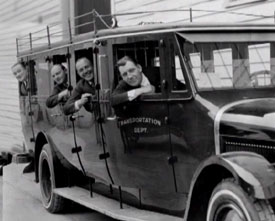 The one new documentary is The Dawn of Sound: How Movies Learned to Talk (2007). It covers the development of sound films from the 1890s to the 1930s. The one new documentary is The Dawn of Sound: How Movies Learned to Talk (2007). It covers the development of sound films from the 1890s to the 1930s.
The idea that sound films began with The Jazz Singer (1927) is quickly revealed to be false, although the commercial success of talkies began then. There are numerous reasons why earlier audiences wouldn't let go of silent movies, the main one being how poorly sound played back in the theater.
We get a scene from Nursery Favorites (1913), a very early experimental talkie from the Edison Manufacturing Company, & the even earlier Dickson's Experimental Sound Film (1898) of a gay couple dancing to "The Cabin Boy." The narrator fails to note this early experiment, though surviving & well known now, was never at the time seen by the public.
During a visit to the Edison Museum, the curator is allowed to get away with the whopper that cinema begins with Edison. He actually had only a businessman's interest in the inventions of others, & an egotist's desire for credit, but the hands-on inventors & filmmakers at Edison Manufacturing did not include Thomas Edison.
And the earliest sound films were difficult to show audiences with the restrictive technology available, & Edison would soon tell his pioneer filmmakers at the studio called Black Maria to just stop wasting money on the idea of talking pictures.
We also get a glimpse of D. W. Griffith in a speaking introduction to his awful film Dream Street (1921). Even Griffith realized his silent film stank, & the novelty of a "talking" prologue was necessary to drag in the crowds.
Such poor use of sound in the earliest attempts did not much argue in favor of the commercial possibilities. Effective technology frankly did not yet exist to do it right. Today we can hear the sound of some of these primitive efforts & it's surprising how really great the recordings were. But we have better sound systems now. In the 'teens & early 'twenties the ability to record sound far exceeded the ability to replay it to a large audience.
Lee de Forest, inventor of the first vacuum tube, developed the Phonofilm process, the first with sound recorded directly onto film. Both the recording & the playback was poor with his process, & film-goers just didn't like the crackling weak sound.
For a short time he partnered with Theodore Case who had developed essential improvements for sound-on-film, & the documentary shows some of his sound home movies with his family that are better than de Forest's attempts at commercial films.
Their partnership might've gone somewhere useful if de Forest hadn't been, like Edision, a self-important egotist. He treated Case as a hireling rather than an inventor of signal consequence, & Case soon took his marbles, or his process, & went to work for Fox.
Vitaphone, a division of Warner, working with Western Electric had a way of recording much better sound on discs, these to be shown alongside the films. The projector-with-sound-turntable would keep the picture & sound synchronized only if the needle never skipped or the film never broke. It was too clunky a system for feature films but it worked pretty well for ten minute one-reel films of which hundreds were made.
The almost heroic devotion of Sam Warner to developing these films is a major focus of the documentary. Despite a poor running record for the public's acceptance of sound movies, Sam continued to believe that if the presentation could be improved, it would define the future of cinema. The tragedy of his early death immediately before the release of The Jazz Singer makes his story especially poignant, since he never saw how right he was.
The rise of Vitaphone pictures is well covered with many fine scenes quoted from nuymerous films. There follows coverate of the founding of Fox Movietone & the pay-off for Theodore Case in the sound-on-film process that fixed the Vitaphone problem of easy synchronization, resulting in the rise of the News Reel talking picture shorts even while silent feature films were still being made.
Much else gets brief mention in this overview that answered "How" motion pictures transitioned into the sound era. It's a pleasant introduction to the topic.
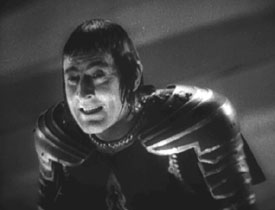 The Voice that Thrilled the World (1943) is a promotional documentary from Warner Brothers, peddling in particular the soon to be released Yankee Doodle Dandy (1944) starring James Cagney doing the song & dance man stuff for a change of pace. The Voice that Thrilled the World (1943) is a promotional documentary from Warner Brothers, peddling in particular the soon to be released Yankee Doodle Dandy (1944) starring James Cagney doing the song & dance man stuff for a change of pace.
The narrator insists it took one-hundred years to make this film, apparently counting the dawn of still photography as part of the history of cinema.
We're shown a history of the development of film technology at the hands of Edison, Easton, & others, leading to the film's premise that the most important of all is Warner Brothers for the advent of sound.
We're shown bits of John Barrymore's silent film Don Juan (1926) which had music & sound effects added as an afterthought, & with a tacked on song sequence. Much focus is given the part-talkie The Jazz Singer, with Jolsen possessing "the voice that thrilled the world."
We learn a bit about the poor film The Lights of New York (1928) which was the first feature-length all-talkie. One scene fails to explain why people hover around a candlestick telephone to speak their lines.
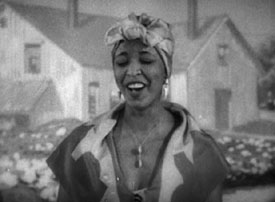 When more people wanted to see this bad film than went to see far more sophisticated silents, it was undeniable that the dam had broken. Soon all manner of dramatic films & historical tales & literature adapted to screen, as well as musicals, flooded onto the no longer silent screen. When more people wanted to see this bad film than went to see far more sophisticated silents, it was undeniable that the dam had broken. Soon all manner of dramatic films & historical tales & literature adapted to screen, as well as musicals, flooded onto the no longer silent screen.
Some stars who spoke English badly or had odd voices never made the transition. But for many a new dramatic star, such as Bette Davis, it was a boon to be able to make full use of their voices.
Then there were informative newsreels that presented to the public images of terrible wars, invariably in a propogandistic context. Unashamedly the narrator boasts that even dramatic tales were the vanguard of "propaganda with our every invasion."
Films had become an intrical part of the war effort by serving foremost government & military requirements (as opposed to the peoples' need for honest facts, which is something this documentary cannot confess). At this point the documentary peters out into a propoganda film itself.
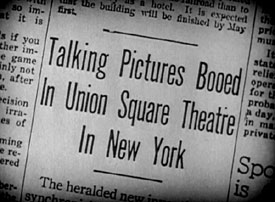 Okay for Sound (1937) was produced for the 20th Anniversary of sound films, counting not from the first sound films but form 1927's The Jazz Singer, to insure the focus is on Warner Brothers sudio. Okay for Sound (1937) was produced for the 20th Anniversary of sound films, counting not from the first sound films but form 1927's The Jazz Singer, to insure the focus is on Warner Brothers sudio.
It seems awfully late to still be bragging films now have sound, but it's even so a fun, naive little documentary.
There's a superficial introduction on the techological developments by Edison, Bell, & others in developing sound recording & replay equipment. We see appealing fragments of an early Vitaphone talkie featuring the New York Philharmonic Orchestra & similarly high-brow performances.
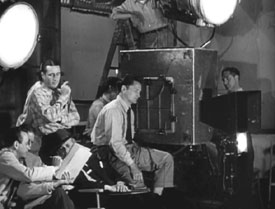 Clips from Don Juan are given as example of the first complete soundtrack for an otherwise silent movie, a bizarre "bridge" between silent & talking films in that a great deal can be heard in terms of sound FX though the actors continue otherwise to dwell in a world without voices. Clips from Don Juan are given as example of the first complete soundtrack for an otherwise silent movie, a bizarre "bridge" between silent & talking films in that a great deal can be heard in terms of sound FX though the actors continue otherwise to dwell in a world without voices.
And then, ta-da, The Jazz Singer arrives its long sound sequence & great songs, followed by the first all-talkie The Lights of New York, & Jolson's all-talkie The Singing Fool (1928), with great clips for each.
Skipping to "twenty years later" we see clips from then-current films & then the documentary winds down, having been nothing at all special, but more than bearable.
After these other documentaries one expects more of same from When the Talkies Were Young (1955). Instead, we have minimal narration to a collection of clips of films Warner Brothers clearly considered their best, & it is rather a glorious batch of clips or trailers.
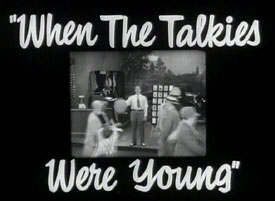 We see bits of Sinner's Holiday (1930) the first film with James Cagney, together with Joan Blondell, with colorful scenes of a Coney Island style carnival & arcade, & some Prohibition era gangster action. We see bits of Sinner's Holiday (1930) the first film with James Cagney, together with Joan Blondell, with colorful scenes of a Coney Island style carnival & arcade, & some Prohibition era gangster action.
20,000 Years in Sing Sing (1932) clips show us a fresh young Spencer Tracey as a prison thug. Five Star Final (1931) highlights Edward G. Robinson as a seedy newspaper editor who grows a conscience when the innocent are injured to sell papers.
Night Nurse (1931) stars Barbara Stanwyck as the nurse hired by an appalling, wealthy family, whose lives have become dominated by the chauffeur, played with shocking charisma by funny-looking but cruelly sexy Clark Gable.
The last clip in the set is for Svengali (1931), with John Barrymore as the spooky old dude with mesmeric power over Trilby (Marion Marsh). The rooftop sets in the German Expressionist style are awesome & practically the whole story is condensed right down to Svengali's demise.
Additional material on this disc includes the two surviving scenes from the otherwise lost musical Gold Diggers of Broadway (1929), the promotional documentary The Voice from the Screen (1926), & an instructional cartoon which Max Fleischer made for Western Electric Finding His Voice (1929).
copyright © by Paghat the Ratgirl
|
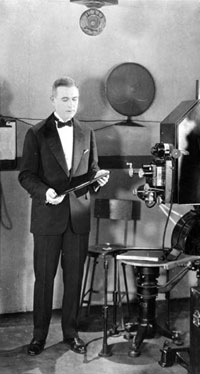
 The one new documentary is The Dawn of Sound: How Movies Learned to Talk (2007). It covers the development of sound films from the 1890s to the 1930s.
The one new documentary is The Dawn of Sound: How Movies Learned to Talk (2007). It covers the development of sound films from the 1890s to the 1930s.
 When more people wanted to see this bad film than went to see far more sophisticated silents, it was undeniable that the dam had broken. Soon all manner of dramatic films & historical tales & literature adapted to screen, as well as musicals, flooded onto the no longer silent screen.
When more people wanted to see this bad film than went to see far more sophisticated silents, it was undeniable that the dam had broken. Soon all manner of dramatic films & historical tales & literature adapted to screen, as well as musicals, flooded onto the no longer silent screen.
 Clips from Don Juan are given as example of the first complete soundtrack for an otherwise silent movie, a bizarre "bridge" between silent & talking films in that a great deal can be heard in terms of sound FX though the actors continue otherwise to dwell in a world without voices.
Clips from Don Juan are given as example of the first complete soundtrack for an otherwise silent movie, a bizarre "bridge" between silent & talking films in that a great deal can be heard in terms of sound FX though the actors continue otherwise to dwell in a world without voices. We see bits of Sinner's Holiday (1930) the first film with James Cagney, together with Joan Blondell, with colorful scenes of a Coney Island style carnival & arcade, & some Prohibition era gangster action.
We see bits of Sinner's Holiday (1930) the first film with James Cagney, together with Joan Blondell, with colorful scenes of a Coney Island style carnival & arcade, & some Prohibition era gangster action.